Contractors’ Guide to Local SEO: How to Dominate Google’s 3-Pack

Ding! That’s the sound of another missed opportunity.
Every time a potential client searches for a contractor in your area and you don’t appear in Google’s coveted top slot, you’re handing business over to your competition. Now, we know generosity is good, but nobody in their right mind should be this generous.
What if you could swing the digital pendulum in your favor? We’re living in an era where a strong online presence is as essential as the sturdiest foundation you lay. And here’s the kicker: achieving stellar online visibility is less about figuring out complex algorithms and more about understanding your local clientele.
If you’ve been laying bricks and wondering why you’re not laying digital tracks at the same time, this is your wake-up call. It’s time to grab your digital toolkit and drill deep into the bedrock of local SEO solutions.We’re ready to show you the way!
1. Understand Google’s 3-Pack
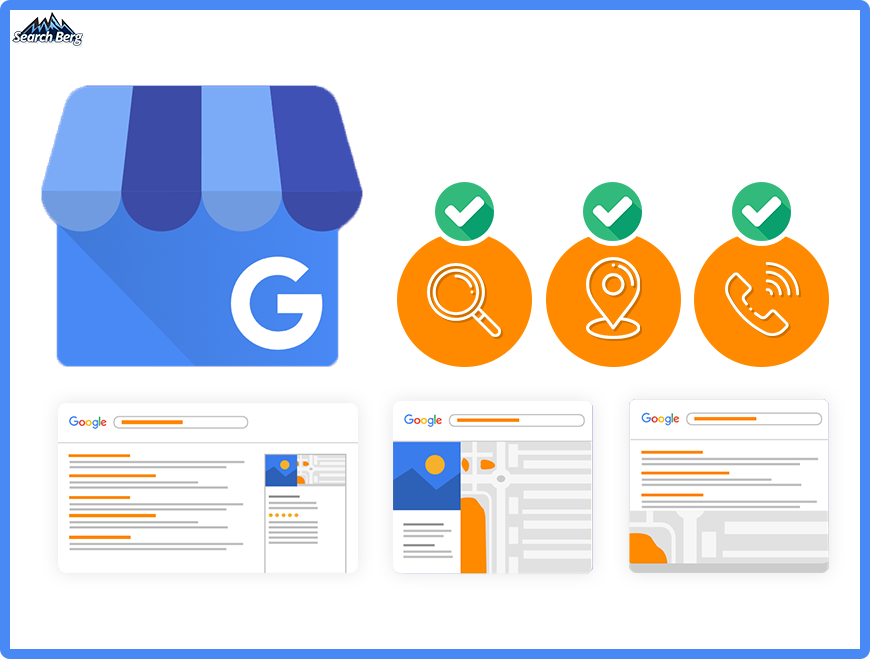
If you’ve ever tapped into Google to find a local business or service, you’ve probably come across a compact box showcasing three businesses at the very top of the search results. This is the illustrious Google 3-Pack; it’s a critical component of local search.
Let’s quickly consider an example before we delve deeper.
Let’s say a web user searches the web for “best contractors in NYC.” This is a local search with local intent, i.e., the web user is looking for businesses in their location. Google Maps plays a big factor in local searches. You won’t just fetch generic results; you’ll fetch map-driven results that help you find exactly what you’re looking for within the confines of your preferred destination.
What would the search results look like in this case? Here’s a glimpse:
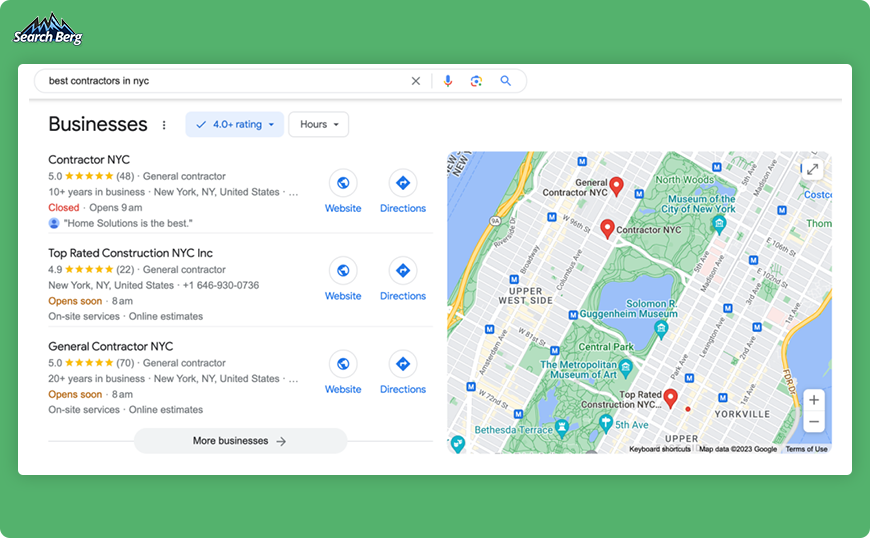
This is Google’s Local 3-Map in a nutshell. It shows up every time a local search is run. If your construction firm targets specific towns, cities, or states, this is for you. Launch a power-packed local SEO service plan with a focus on Local 3-Map optimization, and your rankings will skyrocket. Ignore it, and all you’ll hear is crickets.
If you’re new to all this, don’t worry, we’re about to take the reins for you. Our local SEO providers will carefully walk you through the top strategies and help you dominate Google’s Local 3-Map. We’ll also touch upon the importance of turning to an experienced local SEO firm for professional local SEO services. By the end of this blog, you’ll be equipped with the right knowledge, resources, and direction needed to play your ace. Let’s get the ball rolling!
2. Build a Strong Foundation with Google Business Profile (GBP)
You wouldn’t build a home without laying a solid foundation first, would you? Similarly, in the digital realm, contractors aiming for the coveted Google 3-Pack must start with a robust Google Business Profile.
Think of GBP as the concrete foundation that supports your online presence. GBP creation and optimization is a part of every star-studded local SEO service package (even affordable local SEO service plans).
2.1. What is Google Business Profile?
Google Business Profile, formerly known as Google My Business, is a free tool offered by Google. It allows businesses to monitor and manage their online presence across Google and its associated platforms. Think of it as a snapshot of who you are, what you do, where you’re located, how customers feel about your services, and so on.
2.2. Laying the Local SEO Foundation with GBP: Steps for Contractors
- Claim & Verify: Start by claiming your business on Google. Verification is a simple process; follow the instructions to a tee and wait for a postcard containing a unique code to be delivered to your business address. This step is critical; it tells Google you’re the real deal.
- Detailed Information: A successful foundation requires precision. Fill out every possible detail on your GBP: your full business name, address, contact number, hours of operation, website URL, attributes, and so on. Contractors must specify the type of contracting work (e.g., residential, commercial, plumbing, roofing) to provide clarity to potential clients. Your local SEO company can help you with this.
- Use High-Quality Images: First impressions matter. Upload high-resolution images of your projects, team, and equipment. Showcasing completed projects is an excellent way to instill confidence in prospective clients; you’ll give them a visual taste of your craftsmanship. Advanced Builders & Contractors is an excellent example. Their GBP is filled with relevant photos neatly categorized into various categories (e.g., exterior, interior, street view, etc.).
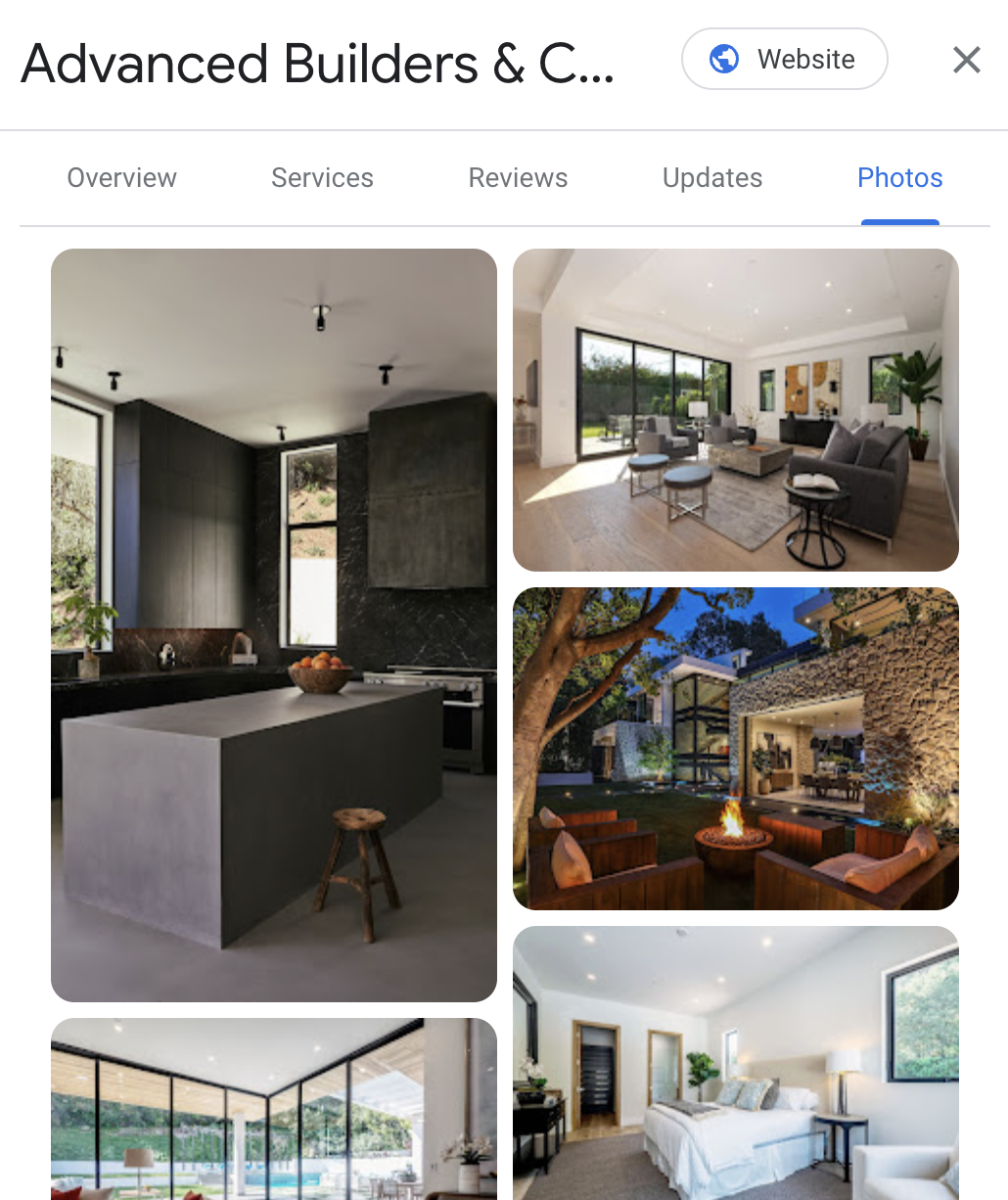
- Regular Updates: Just like you’d maintain a foundation to prevent cracks, keep your GBP updated at all times. Whether you’ve expanded your services, adjusted your hours, or moved to a new location, ensure your profile reflects these changes.
- Encourage Reviews: Word of mouth often takes the form of online reviews in the digital age (more on this later). Prompt satisfied clients to leave positive feedback on your GBP. Actively respond to these reviews (both positive and negative) to showcase your commitment to client satisfaction. Joel & Co. Construction is known for taking the time to craft personalized responses to client reviews.
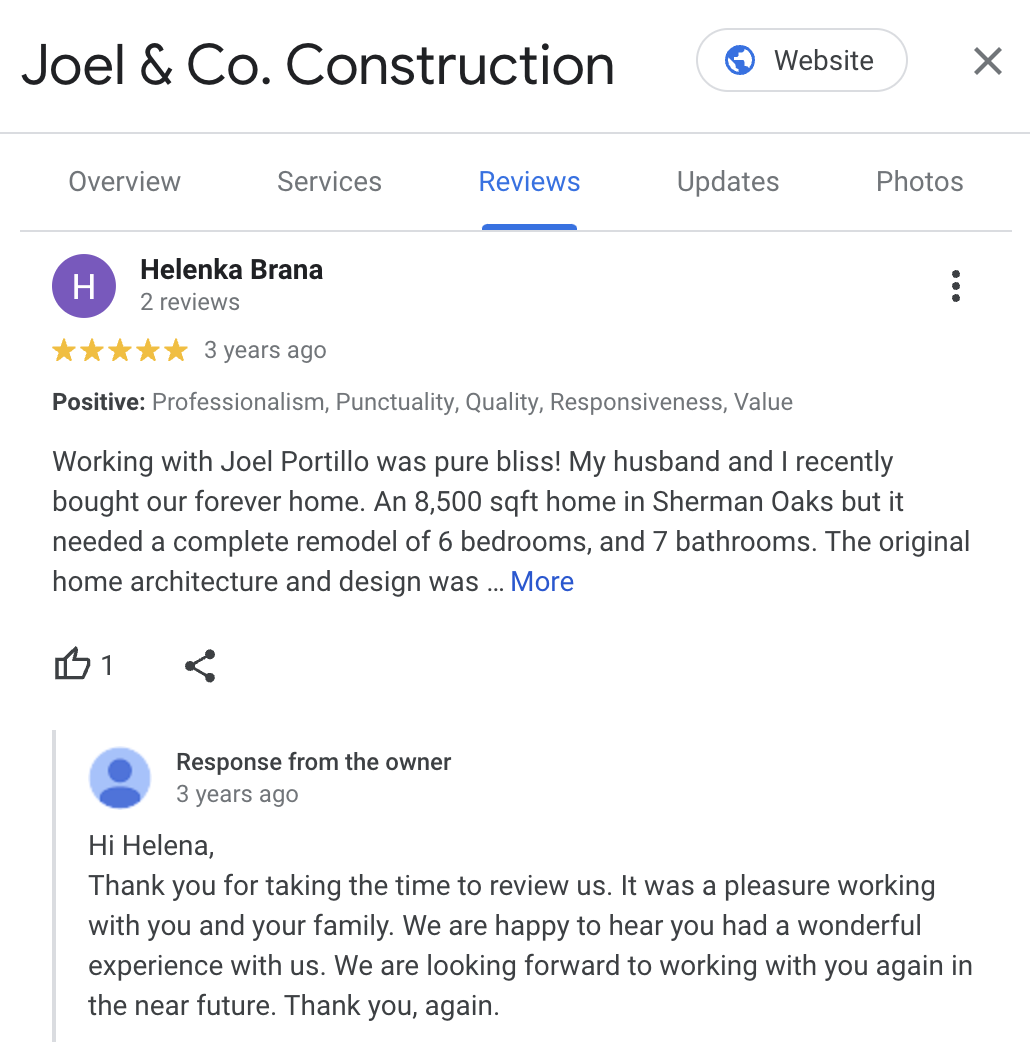
This is a great way to develop a bond with your audience. When you engage with a client, they feel valued, seen, and validated. They’re not just another customer anymore; they’re a part of your business community. This level of interaction goes beyond a transactional relationship and fosters a deep connection.
And you’re not just pleasing your audience; you’re also pleasing Google. Google strives to provide the most relevant and valuable information to users. When you respond to reviews, you add more context and information to your business listing. This enhances the user experience by giving potential customers a better understanding of your business and how you interact with your clients.
The outcome? Sweeter rankings.
- Utilize the Posts Feature: GBP allows you to create posts about updates, offers, or events. If you’re offering a seasonal discount on home renovations or hosting a DIY repair workshop, post about it! This is a great way to engage and inform your audience directly. If you’re new to GBP, don’t worry. Work with local SEO providers who can take the reins for you.
Recommended Read: How to Completely Optimize and Promote Your Google Business Profile Page
3. Steal the Show with Local SEO Content

If Google Business Profile is your foundation, local SEO content is the dazzling architecture that makes passersby stop and admire.
This is your opportunity to step outside your comfort zone and give your audience more than just a brief, impersonal glance at your services. It’s your stage, your spotlight, and the microphone is all yours.
But what exactly is local SEO content, why is it so important, and why should it be a part of your local business SEO service package?
3.1. What is Local SEO Content and Why Does It Matter?
Local SEO content is content that specifically resonates with your local audience. This is where you move away from generic terms like “best contractor” and explore targeted, local keywords like “top roofing contractor in Chicago.”
The goal is to craft content that speaks to local interests, needs, and queries. Local SEO content provides information that’s not only valuable but also geographically relevant.
Why? For starters, people love local content. They’ve evolved past the point of wanting general information. When browsing, they’re not just looking for “how to fix a leaky roof.” Instead, they want to know the “best methods to fix a leaky roof in Seattle,” especially given Seattle’s unique weather conditions.
This sense of locality in content creation adds a personal touch; it’s a nod to the audience that says, “I understand where you’re coming from.”
Secondly, Google, with its astute algorithms, also loves local content. It recognizes the importance of serving pinpointed results to its audience. Google cares about relevance, and what’s more relevant than serving geographically accurate content in response to localized queries?
By peppering their content with local keywords, contractors are essentially conversing in Google’s preferred language. For instance, a piece focused on “desert landscape-friendly constructions in Arizona” is far more likely to top SERPs than a more general “desert-friendly constructions.”
Google loves precision, and local SEO is the epitome of precise content targeting. As a rule of thumb, always hire local SEO services that come with local SEO content creation, optimization, and marketing.
3.2. How to Create Local SEO Content
Mastering the craft of local SEO content isn’t about reinventing the wheel; it’s about understanding the terrain you’re navigating. For contractors, this means developing a keen awareness of local needs, nuances, and narratives.
Here’s how you should go about it:
- Understand Your Local Audience: Before you hammer the first nail, make sure you know exactly who you’re building for. Dive deep into local issues, preferences, and needs. Conduct surveys, engage in local community events, and have informal chats with your clients to understand their pulse. An experienced local SEO firm can help you with audience research.
- Keyword Research with a Local Twist: Once you understand your audience, start researching keywords that resonate with your local audience. Use tools like Google Keyword Planner to identify high-ranking local keywords for your unique industry and audience.
We also recommend focusing on long-tail keywords with local identifiers like “roof repair in [city name]” or “[city name] kitchen remodeling services.”
- Address Local Issues: As a contractor, your services are intrinsically tied to your target region’s physical and environmental challenges. Identifying and recognizing these challenges can be the cornerstone of your content strategy.
Maybe your area frequently encounters natural events like floods, hurricanes, or earthquakes. These events can present various housing concerns like foundation cracks and damaged roofs.
By understanding these issues and crafting local content accordingly, you’ll offer immense value to your audience. For instance, writing an article about “Preparing Home in [City Name] for Hurricane Season” will inform and educate your audience.
It’s important to remember that different cities and regions have different construction codes, permits, and regulations. Offer insight, clarifications, or updates on these regulations to provide clarity and showcase your expertise. An example? “Navigating [City Name]’s New Building Codes for Residential Areas.”
We also recommend keeping abreast of local tastes and preferences in home styles and resonations; these vary from place to place. Maybe barn-style homes are trending in your region. If so, request your local SEO provider to create content accordingly. Or perhaps there’s a surge in demand for sustainable constructions.
Similarly, the availability of certain construction materials may vary based on the region. If there’s a scarcity of a particular resource in your area, create content around alternative materials or methods, e.g., “Alternatives to Hardwood Flooring in [City Name]: What Homeowners Should Know.”
See what we’re talking about? The more experienced, skilled, and knowledgeable your local SEO company, the better. You won’t have to instruct them; they’ll take care of all the legwork themselves.
- Highlight Local Projects: Nothing speaks louder than your actual work. Showcase recent projects in the area. A detailed case study, before-and-after images, or client testimonials can authenticate your content while making it highly localized.
- Integrate Local News and Events: Stay updated with what’s happening in your vicinity. If there’s a local housing fair or a construction exhibition, create local SEO content around it. Similarly, if a local news segment highlights increased property values, curate content discussing home improvements that can further elevate property worth.
By syncing your content with local narratives, you’ll improve your SERP rankings and resonate deeper with your community. This is a great way to prove that you’re not just another contractor; you’re a community member in tune with local happenings, trends, and concerns.
Recommended Read: Real-Time SEO Content Writing: A 7-Step Process for Everyone
If you want to create engaging, insightful, and high-quality content that wows your audience, consider hiring a local SEO company that provides professional local SEO services.
When the pros take the reins, your content will be informative, unique, creative, and compelling. It won’t just predictably walk readers through run-of-the-mill insights in a boring fashion; it’ll weave a gripping story that keeps readers glued to their screens till the very end.
Anyone can provide knowledge. But providing knowledge in an engaging and creative manner is an art very few have mastered. When you work with an experienced local SEO firm, you’ll achieve a masterful local SEO content balance that engages and converts your audience.
And nobody knows how to pepper content with the right amount of expertise, creativity, innovativeness, and keywords better than Search Berg! Explore our content marketing services to see what we can do for you.
4. Reviews: Let’s Chat About Chatter

In the bustling marketplace of the digital age, where every contractor claims to be the best in the business, there’s a more subtle yet powerful currency at play: chatter.
While you’re busy with beams and bricks, a parallel construction project is in the works online, built with words and experiences. This is the world of reviews.
4.1. Why the Buzz Matters
We’ve all been there. At some point, everyone has hovered over a purchase online and scrolled down to see what people are saying about the product/service.
Similarly, before a homeowner or business entrusts you with renovating their sacred space, they’ll dig into your reviews to see what previous clients have to say about your work, work ethic, customer service, and so on.
Whether it’s a full-blown story or just a star rating, every review shapes audience perception.Before that first handshake or exchange of blueprints, trust is established online. Positive reviews act as digital character references; they vouch for your skill and integrity.
Just like you’ll check reviews before hiring a local SEO services company, your clients will do the same with you. You must be prepared for that moment.
4.2. Nurturing the Review Ecosystem
The modern contracting world isn’t solely about bricks and mortar; it’s also about the bedrock of trust, and trust is often cultivated from the seeds of reviews.
Here’s how you can nourish and grow this vital aspect of your business:
- Ask, Don’t Assume
The art of acquiring reviews often starts with a simple ask. While your work may leave clients speechless (in a good way), they may not always vocalize their satisfaction online. A gentle reminder post-project can make all the difference.
Personalize your request: recount a memorable moment or aspect of the project when asking. This is a great way to demonstrate your genuine involvement and prompt a more detailed and personalized review in return.
- Make It Easy
Time is a commodity for everyone. If you request a client leave a review, streamline the process for them.
Provide direct links to your review platforms or even offer a QR code on a business card to remove potential barriers. Additionally, offer a brief guide or pointers on what the review could cover, e.g., timeliness, quality of work, or communication.
This will help simplify the process for them and fetch comprehensive feedback. It’s like feeding two birds with one scone! Your local SEO provider can help with this.
- Respond with Grace
In the digital age, dialogue is ongoing. Engaging with your reviewers isn’t just courteous; it’s pivotal.
For glowing reviews, a personalized thank you can reinforce client relationships. For critiques, pause and understand the root of the concern. Address feedback openly and professionally to demonstrate a commitment to excellence.
It’s important to note that prospective clients don’t just read the initial review; they also go over the response. Think of the latter as a window into your ethos.
In some cases, construction businesses also fall victim to false reviews and ratings. These may be generated by competitors aiming to tarnish your reputation or just by random individuals. While the reasons vary, the outcome remains consistent: significant damage to the business’s credibility and, in turn, loss of potential clients.
Let’s delve into an example:
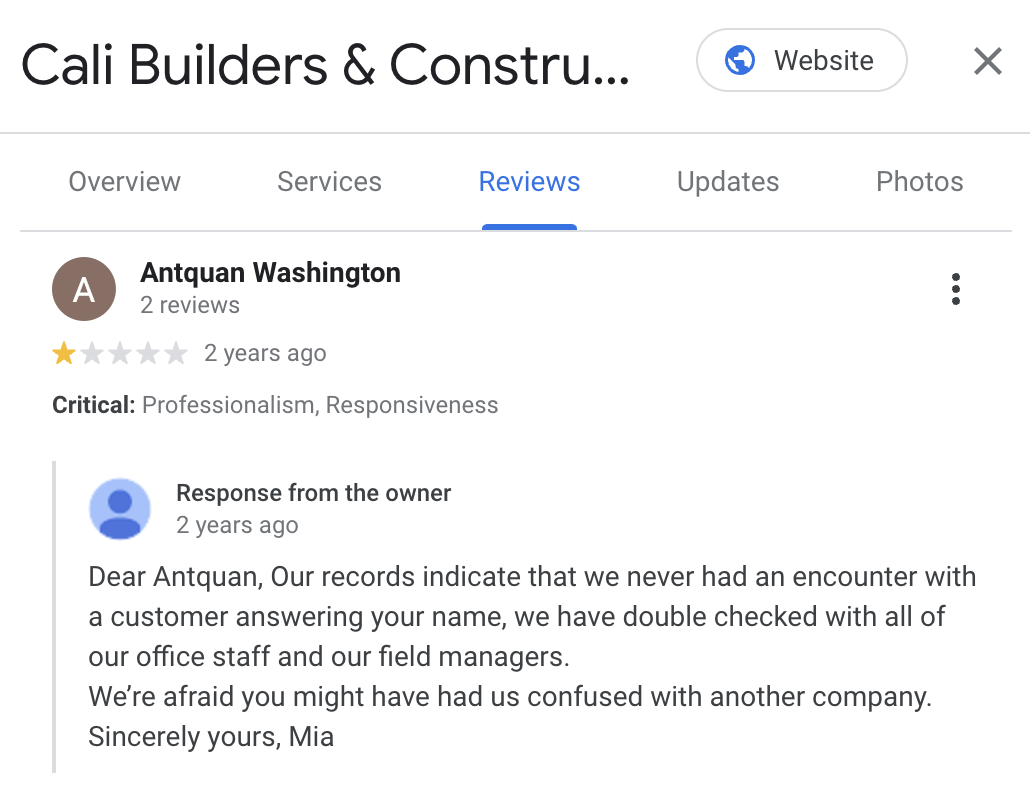
This rating could have done significant damage had the business not intervened. Mia’s response is a template for how businesses should handle such situations. She was polite, concise, and straightforward. There was no aggression, just a simple statement of facts.
This approach is critical. When addressing a potentially fake review, always remain calm and professional, research internally to ensure the claim is false, and provide clarity. While false reviews will turn away potential clients, they’ll also upset Google. The outcome? Your chances of appearing in the Local 3-Map will go down.
Stay on top of your game to keep both customers and Google happy. We also recommend taking some time to ensure your local business SEO service package also includes reputation management.
- Flaunt the Good Stuff
Standout reviews are gold; integrate them into different facets of your marketing. Whether you’re updating your website’s testimonial section, posting on social media, or incorporating quotes in printed brochures, ensure these authentic voices reach your wider audience.
- Learn and Evolve
Online reviews are more than just digital applause or feedback; they’re a tool for evolution. By actively analyzing patterns in feedback, you can uncover areas of consistency and areas for improvement.
Maybe clients consistently praise your punctuality but wish for more frequent updates during projects. These insights are invaluable. Act on them. Use this feedback loop as a compass to align closer with client expectations and needs.
5. Start Ranking with On-Page SEO
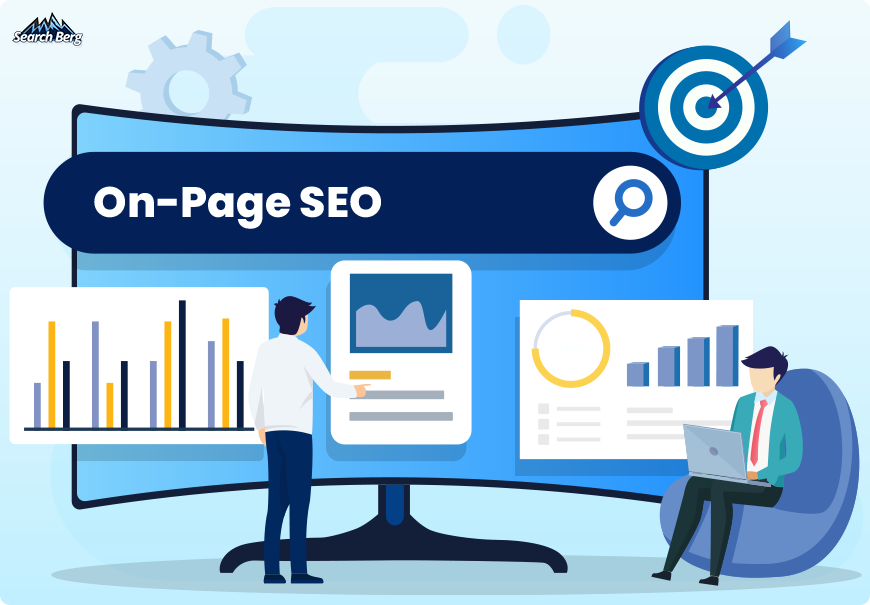
Great, you’ve created content. Now what? Your local SEO service bundle shouldn’t just include local content creation; it should also include on-page SEO.
The latter is a neat little trick that’ll pick your business and strategically place it into Google’s Local 3-Map. How can you check this box off the list? Let’s dig deeper.
5.1. Title Tags & Meta Descriptions
A title tag defines the title of a webpage; it’s displayed on SERPs as the clickable headline for a given search result.
For instance, if you have a page about “Kitchen Renovations,” its title tag may be “Premium Kitchen Renovations in [City Name] – [Your Company Name].” See what we mean?
To craft an effective title tag:
- Prioritize Relevance: Title tags should succinctly reflect the page’s content. If the title is about bathroom designs, include “bathroom designs” in the tag.
- Incorporate Key Keywords: Ideally, place your main keyword toward the beginning.
- Keep It Concise: Keep the tags under 60 characters to ensure they display properly in search results.
- Uniqueness: Each page on your website should have a distinct title to avoid confusion and enhance clarity for search engines and users.
Meta descriptions offer a summary of a webpage’s content and appear under the title tag on SERPs. Taking the same example above, the meta description may read: “Explore top-tier kitchen renovations in [City Name]. We have over ten years of experience in turning culinary spaces into modern masterpieces.”
To craft a compelling meta description:
- Be Descriptive: Summarize the page’s content accurately. Cover your USPs; give web users a reason to click!
- Use Keywords: Incorporate relevant keywords naturally. This helps users confirm the relevance of your page. It also increases your chances of appearing in Google’s 3-Pack.Ask your local SEO provider for an updated list of local keywords each month.
- Mind the Length: Aim for about 150–160 characters to ensure the full description is visible on SERPs.
- Unique Descriptions: Every webpage should have its own meta description. Avoid using the same meta description across different webpages. Googlebot will quickly notice what’s happening and lower your rankings.
5.2. URL Structure
The structure of a URL is more than just a web address; it’s a critical component of effective local SEO and user experience. A clear and concise URL helps users and search engines understand and reach your content effortlessly.
- Simplicity is Key: Your URLs should be as straightforward as possible. Instead of using a convoluted string of numbers and symbols, aim for a simple, readable structure.
For instance, a page about bathroom renovations should ideally have a URL like www.yourdomain.com/bathroom-renovations.
- Keyword Integration: Embedding relevant keywords into your URL is a great way to enhance its SEO value. If you offer kitchen remodeling services in New York, opt for an intuitive and SEO-friendly URL like www.yourdomain.com/new-york-kitchen-remodeling.
- Avoid Lengthy URLs: We get it; you may be tempted to capture every little detail in your URLs. However, it’s best to avoid making them too long.
Concise URLs are easier for users to recall and share. If a URL extends beyond three to five words, it’s probably worth revisiting.
- Use Hyphens, Not Underscores: Hyphens are preferable to underscores because search engines read hyphens as spaces. Opt for something like kitchen-remodeling instead of kitchen_remodeling.
- Consistency and Structure: Websites with multiple pages must maintain a consistent URL structure. This is a great way to help search engines crawl and index your site with ease. You’ll also end up giving visitors a logical path through your site.
Now, things may get a little technical here. On-page SEO may sound fun and games, but it’s more complex and nuanced than you may think. Hire local SEO services to lift this weight off your shoulders.
An experienced local SEO company will review your website’s URL structure and make necessary adjustments to ensure it’s clean, organized, and keyword-rich. They’ll also ensure the URLs are descriptive and follow a logical hierarchy that reflects your website’s content structure.
5.3. Image Optimization

Images play a pivotal role in the visually-driven world of the internet.To captivate potential clients, contractors can showcase stunning visuals of completed projects, detailed blueprints, or even action shots of ongoing work.
However, merely uploading high-resolution photos isn’t enough. Stellar image optimization is your golden ticket to delivering the visual impact you desire! And, of course, image optimization will also fill your glass with ranking juice until you make it to Google’s Local 3-Map. All optimization efforts help, and this is no different.
- Quality vs. Size: High-resolution images are detailed and sharp, but they also come with hefty file sizes that can slow down your website. Use tools like Photoshop and GIMP to compress images and preserve quality while reducing file size. If your local SEO provider uses their own image compression tool, even better!
- Alt Text: Every image on your website should have alternative text (often called “alt text”). This brief description helps search engines understand the content of the image. This can be particularly useful for contractors. An image with alt text like “custom hardwood kitchen cabinets” can boost SEO while providing context.
- Descriptive Filenames: Instead of leaving an image with a default filename like “IMG_1234.jpg”, rename it to something descriptive and relevant like “modern-bathroom-design.jpg”. This helps with indexing purposes.
- Responsive Images: In 2023, there are a multitude of devices and screen sizes available. Using responsive images that adapt to the viewer’s device is imperative. This is a great way to ensure mobile users don’t download large images meant for desktops.
By keeping load times short, you’ll keep your audience happy. And as long as your audience gets what it wants, Google will keep you in its good books!
5.4. Internal Linking
The web of connections within your site, known as internal linking, is much like the intricate wiring of a house. Every link serves a purpose to ensure the entire structure functions seamlessly. Understanding and implementing effective internal linking is essential.
Internal links connect one page of your website to another. This allows users to navigate your site effortlessly, discover new services, explore past projects, stumble upon testimonials, and find other content that could influence their decision to hire you.
Search engines, much like users, rely on these links to find content on your site. By showcasing the relationship and hierarchy between different pages, you’ll make it easier for search engines to index your content.
If you’ve been struggling to make it to Google’s 3-Pack, this little trick will help you rank higher and higher until you sneak into the little coveted box. Here are the guidelines for good internal linking:
- Relevance: The links you provide must be relevant to the content. If you’re discussing kitchen renovations, link to a gallery of your past kitchen projects or a blog post about kitchen design trends.
- Anchor Text: This is the clickable text of your link. Make sure it’s descriptive but concise. Hint at what the user should expect upon clicking.
- Avoid Overlinking: While internal linking is beneficial, it’s possible to overdo it. Aim for a balance. Flooding your content with links can make it look cluttered and decrease its readability.
5.5. External Linking
Stepping beyond the boundaries of one’s website may seem counterintuitive. Why direct traffic elsewhere?
But in the digital realm, external linking (or outbound linking) is like building bridges from your site to others. It strengthens your online credibility and positions you as a well-informed, connected player in your industry.
External links direct your audience to websites outside your domain. By offering them trusted sources for further reading, you demonstrate that your content isn’t isolated but part of a broader conversation in the industry.
When you link to authoritative sources, especially those known in the construction business, you also borrow some of their trustworthiness. And, of course, Google sees external links to high-quality sites as a positive indicator of your site’s value and relevance.
What are the best practices to get things right?
- Quality over Quantity: Instead of linking to every site you can find, prioritize quality. A link to an authoritative industry publication or a reputed contractor association is far more valuable than numerous links to lesser-known, low-quality sites.
- Open in a New Tab: When setting up external links, it’s often good practice to set them to open in a new browser tab. This way, visitors can easily return to your site after exploring the external content.
- Stay Relevant: If you’re discussing the merits of a particular building material, link to studies, manufacturers, or industry reports that support your claims. Irrelevant links can confuse readers and dilute your content’s focus.
- Regularly Check Links: Websites evolve, and content can move. Occasionally check your external links to ensure they’re still active and relevant. Dead links can frustrate users and harm your site’s credibility.
6. Feeling Overwhelmed? Turn to a Professional Local SEO Company!
Exploring the world of local SEO can initially feel like navigating a busy construction site without a blueprint. Everywhere you look, something or the other demands attention, and the intricate details can sometimes feel overwhelming.
At Search Berg, we’re here to help. As one of the leading local SEO firms for construction businesses, we don’t just help you get seen by your audience; we help you outrank your competitors.
We understand that the maze of keywords, content strategies, and Google Business Profile can be overwhelming. By stepping in and taking the reins, we lighten your load and achieve stellar results.
Are you ready to transform your online presence? Explore our local SEO services to get started!We also provide SEO services for contractors who are new to online marketing. If you want a more general approach rather than a specialized plan (local SEO), we’ll start with the basics and work our way up.
Your digital success is a project we’re passionate about. Let’s build it together. We’re ready when you are!












